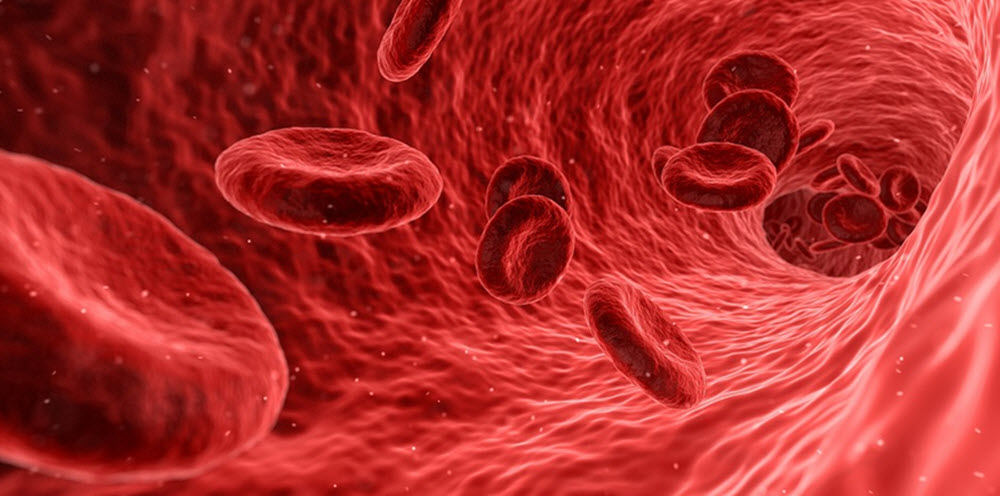Contents
Red blood cells (RBCs) are the most common type of cells in human blood, and they are the reason why our blood is red. The red colour comes from the red haemoglobin present in each red blood cell.
In humans (and many other animals), red blood cells are the body´s principal method of transporting oxygen gas from the lungs to the cells of the body. Red blood cells take up oxygen in the lungs, transport it, and then release it to tissues while squeezing through the capillaries.
In an adult, it takes around 60 seconds for a red blood cell to complete one cycle of circulation.

What do they look like?
A normal human mature red blood cell is a flexible biconcave disc where both faces of the disc have a shallow bowl-like indentation in the centre. The red blood cell is flexible because it has no nucleus. This makes it easier for it to squeeze through blood vessels, but it is a process that also limits the cell´s life span as its membranes are damaged. The average lifespan of a human RBC is three months.
The human red blood cell is smaller than most other human cells, with an average volume of roughly 90 fL. It has the capacity to swell up to circa 150 fL without distenting its membranes.
How many RBC:s do I have?
The answer to this will of course vary due to individual factors, such as size and medical conditions, but an average adult human has around 20-30 trillion red blood cells at any given time. This is around 70%-80% of the number of total cells in the body.
If we look at just one microliter of blood, it will contain around 4-5 million RBC:s for an adult woman and roughly 5-6 million RBC:s if the blood is from an adult man. Individuals acclimated to life at a high altitude where oxygen tension is low tend to have an even higher number of RBC:s per microliter blood.
Hemoglobin
Red blood cells are rich in haemoglobin, an iron-containing biomolecule capable of binding oxygen. Haemoglobin is responsible for the transport of more than 98% of the oxygen in the body. (The rest of the oxygen is transported by the blood plasma.)
In a human red blood cell, we can expect to find roughly 270 million haemoglobin molecules. The red blood cell is shaped in a special way to be able to carry a very large amount of haemoglobin (for its size), and is essentially a ”bag for haemoglobin”. Notably, the red blood cell has no cell nucleus and also lacks most organelles – which frees up more room for the haemoglobin. Haemoglobin constitutes about a third of the total cell volume.
In an average adult male, the iron found in all his red blood cells combined will weigh about 2.5 grams. This represents roughly 65% of the total iron content of his body.
Life cycle of a human red blood cell
Production
In a healthy human adult, approximately 2.4 million new red blood cells are produced per second. The production of RBC:s takes place in the bone marrow of our large bones, and the process is known as erythropoiesis. The development from committed stem cell to mature red blood cell takes around seven days.
Functional lifetime
In a healthy adult, a mature RBC will circulate in the body for 100-120 days before being broken down again. There are several health conditions where this life span becomes greatly reduced.
As the red blood cell gets old, it will be attacked by macrophages and be subjected to phagocytosis. This is the process through which old and defective red blood cells are removed from the blood. Much of the resulting breakdown products are recycled within the body.
History
- The oldest intact human blood cells are the ones found in Ötzi the Iceman, a natural mummy of a man who died around 3255 BCE. These cells were isolated in May 2012.
- The first known description of red blood cells was made by the Dutch biologist Jan Swammerdam, who had been studying blood in his microscope in 1658. This was not human blood; it came from a frog. A more precise description of red blood cells was made by the Dutch microscopist Anton van Leeuwenhoek in 1674.
- In the 1740s, the Italian physician Vincenzo Menghini was able to demonstrate the abundance of iron in red blood cells by using a magnet. Menghini took femoral vein blood from a dog and dried the blood to a powder before using a magnet to test the iron content. He also tested multiple organs and showed that the amount of iron was proportional to the amount of blood in each organ. The experiment was published in a scientific journal in 1746.